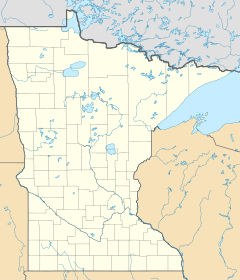Duluth South Breakwater Outer Light

Duluth South Breakwater Outer Light (1985)
|
|
| Location | lake end of south pier of the Duluth Ship Canal |
|---|---|
| Coordinates | 46°46′48″N 92°05′15″W / 46.7801°N 92.0875°WCoordinates: 46°46′48″N 92°05′15″W / 46.7801°N 92.0875°W |
| Year first constructed | 1874 |
| Year first lit | 1901 |
| Automated | 1976 |
| Foundation | Concrete pier |
| Construction | Brick |
| Tower shape | House with square tower |
| Markings / pattern | white with red roof |
| Focal height | 44 ft (13 m) |
| Original lens | Fourth order Fresnel lens |
| Range | 17 nm |
| Characteristic | Fixed Green |
| Fog signal | Horn |
| USCG number |
7-15845 |
|
[]
|
|
7-15845
The Duluth South Breakwater Outer Light is a lighthouse at the end of the south breakwater of the Duluth Ship Canal. It forms a range with the Duluth South Breakwater Inner Light.
The appropriation which paid for the initial construction of this light was made in 1870, with the intent to build a structure at the end of the Northern Pacific Railroad docks. Storm damage, however, delayed construction until 1872, by which point the canal had been dug. A wooden pyramidal tower was erected, initially equipped with a fifth-order Fresnel lens. An elevated walkway led back down the pier; a frame dwelling for the head keeper was constructed nearby, with the assistants required to look for lodging elsewhere in the city. This tower was first lit in 1874.
The area is notoriously foggy, and an automated bell taken from the South Manitou Island Light, the first in a long series of fog signals, was installed in 1880. This was replaced by a pair of steam-powered whistles in 1885, housed in a newly constructed shelter on the breakwater. The noise from these whistles brought complaints from city residents, and a parabolic reflector mounted in a sawdust-filled box was installed in a successful effort to direct the sound out towards the lake. Fog signal operation, it may be noted, averaged 472 hours a year for the first ten years of operation; in 1895 the whistles blew for 1,048 hours, an average of over four hours a day over the eight-month season.
In 1886 the lens was upgraded to a fourth-order Fresnel lens, and the characteristic changed from a red and white flash to a fixed red signal.
The late 1890s reconstruction of the ship canal resulted in the replacement of this tower and the fog signal house with a single brick lighthouse containing both signals. This house, constructed of Cream City brick, was completed in 1901, and the new tower was first lit on September 1 of that year. This tower stood on the southeast corner of the rectangular building, and housed the lens retained from the old light; the fog whistles and their reflector were also moved from the old structure to the new. The latter were replaced in 1915 with locomotive whistles, and in 1921 with Type F diaphones, setting off another round of noise complaints, which led to the installation of a new sound reflector. The diaphones were replaced in 1968 with an electronic horn, but in 1976 a group styling itself TOOT (for "reTurn Our Old Tone") began a campaign to restore the fog signal. Horns from the Kewaunee Pierhead Light were obtained, and in 1995 the diaphones were put back in service, eliciting, of course, a new round of noise complaints, which led to restriction of the signal to daytime operation. The signal required a three-phase current supply for operation, and when this failed in 2005, the Coast Guard refused to pay for repairs; legal concerns led the city to refuse to pick up the tab, and the signal was dismantled the following year. The light, however, continues in service, displaying a fixed green light.
...
Wikipedia

